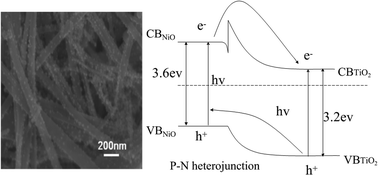Nano-p–n junctions on surface-coarsened TiO2 nanobelts with enhanced photocatalytic activity
Abstract
Nano-p–n junction heterostructure TiO2 nanobelts have been produced by assembling p-type semiconductor NiO

* Corresponding authors
a
Key Laboratory of Processing and Testing Technology of Glass & Functional Ceramics of Shandong Province, Department of Materials Science and Engineering, Shandong Polytechnic University, Jinan, Shandong, China
E-mail:
sjx@sdili.edu.cn
b
State Key Laboratory of Crystal Materials, Shandong University, 27 Shandanan Road, Jinan, China
E-mail:
hongliu@sdu.edu.cn
c Department of Physics and Astronomy, Green State University, Bowling Green, OH, USA
d Section of Chemistry, Aalborg University, Aalborg, Denmark
Nano-p–n junction heterostructure TiO2 nanobelts have been produced by assembling p-type semiconductor NiO

 Please wait while we load your content...
Something went wrong. Try again?
Please wait while we load your content...
Something went wrong. Try again?
J. Lin, J. Shen, R. Wang, J. Cui, W. Zhou, P. Hu, D. Liu, H. Liu, J. Wang, R. I. Boughton and Y. Yue, J. Mater. Chem., 2011, 21, 5106 DOI: 10.1039/C0JM04131A
To request permission to reproduce material from this article, please go to the Copyright Clearance Center request page.
If you are an author contributing to an RSC publication, you do not need to request permission provided correct acknowledgement is given.
If you are the author of this article, you do not need to request permission to reproduce figures and diagrams provided correct acknowledgement is given. If you want to reproduce the whole article in a third-party publication (excluding your thesis/dissertation for which permission is not required) please go to the Copyright Clearance Center request page.
Read more about how to correctly acknowledge RSC content.
 Fetching data from CrossRef.
Fetching data from CrossRef.
This may take some time to load.
Loading related content
